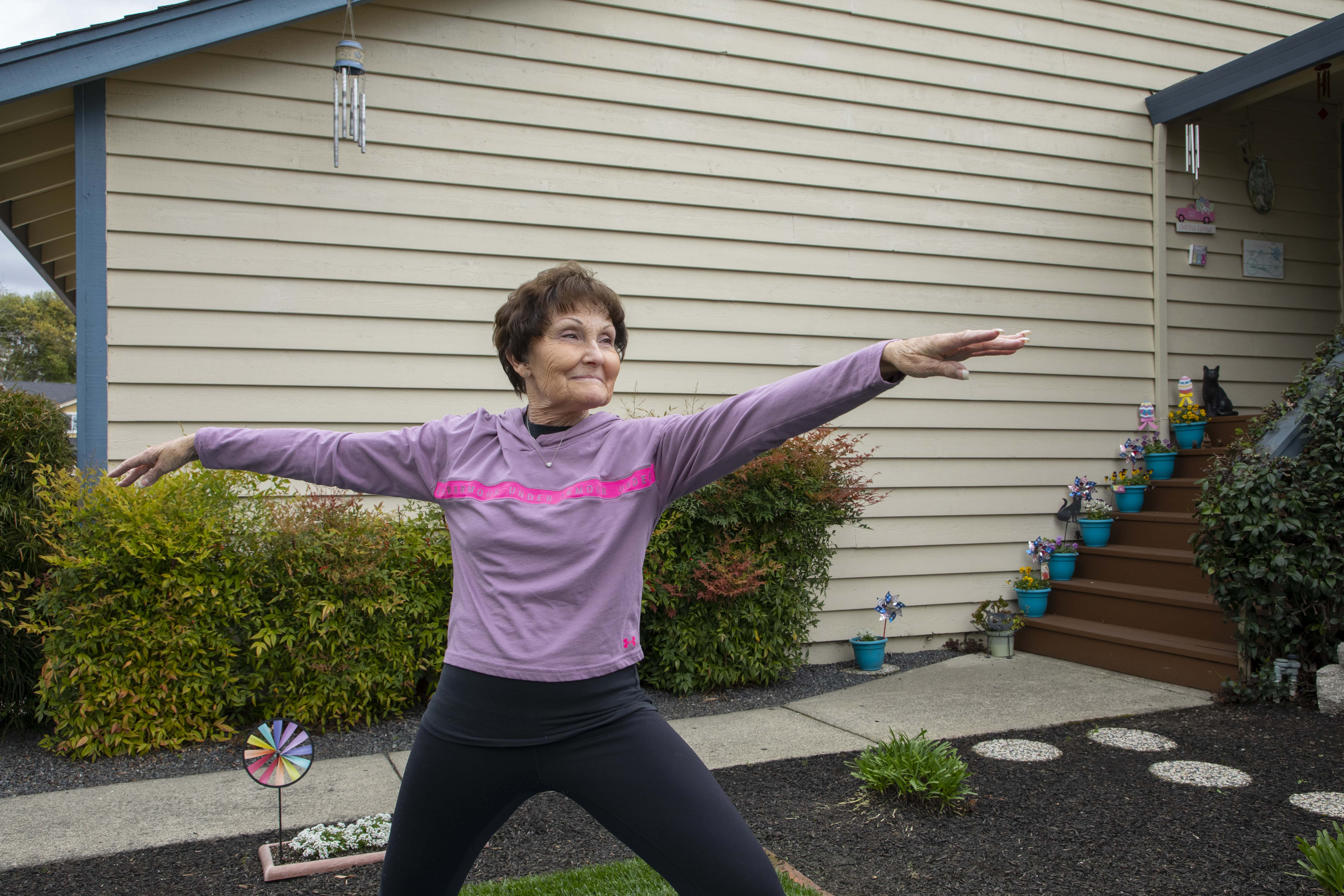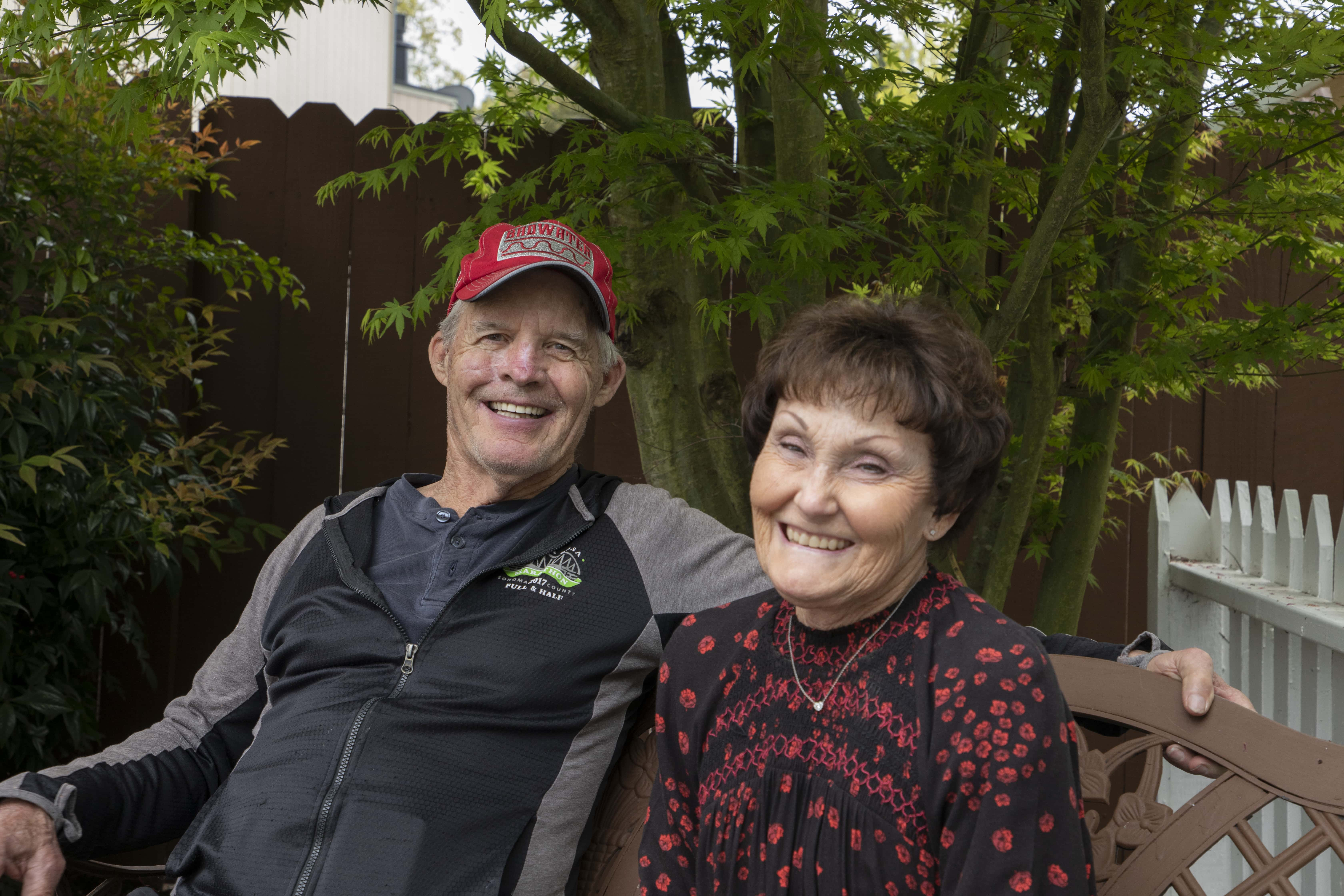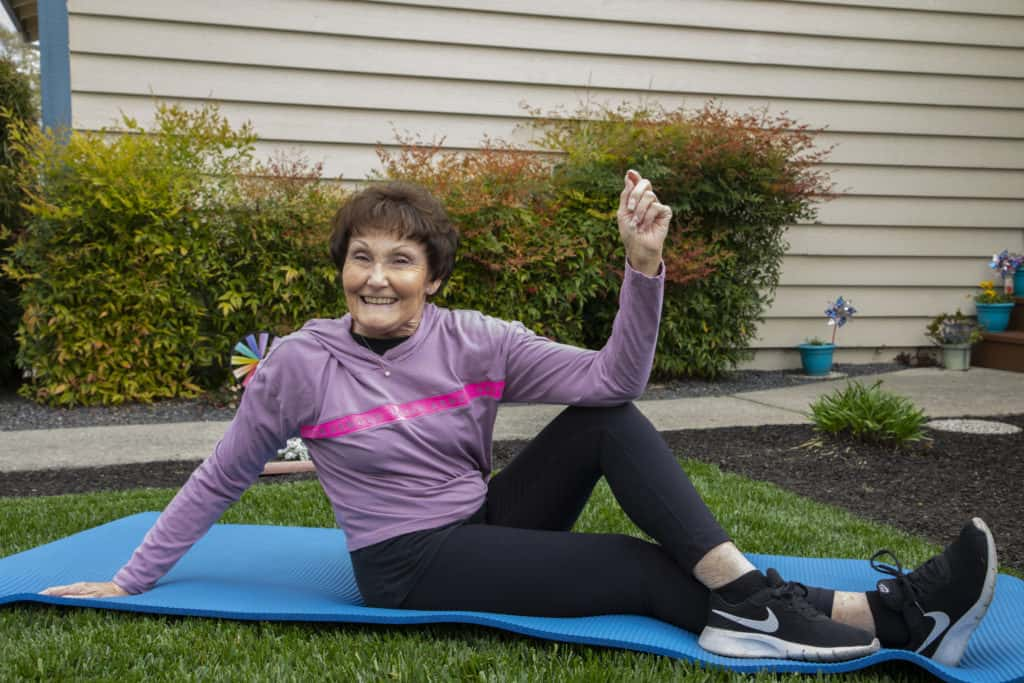
One morning in 2014, Santa Rosa resident Christine Webb thought she had a cold coming on. She didn’t feel well, but as she didn’t have any outwardly noticeable cold or flu symptoms, she still went to work. She arrived early, before other employees, and she felt herself getting very thirsty and clammy—two symptoms she never otherwise feels. She also felt tightness in her chest. When her supervisor arrived around 10 a.m., Webb informed her she wasn’t feeling well and was going home.
As she drove down her block towards her house, her husband, Arthur, an ultra-marathoner, was just heading out for a run. Christine told him to go ahead, she felt she just needed to rest. However, he insisted they go to Kaiser Permanente right away. Later he admitted he knew it was serious because she looked ashen, distant and had shallow breathing—something wasn’t right.
They went to critical care at Kaiser, and after a negative EKG (electrocardiogram) her family doctor immediately wheeled her to the emergency room to further assess the situation with a team of doctors. They decided to rush her to Santa Rosa Memorial Hospital’s Level II trauma center. By chance, a nurse from Santa Rosa Memorial Hospital happened to be at Kaiser, saw what was happening, and called ahead so the team was ready when Webb arrived. She doesn’t remember much after this point, waking up two days later in a hospital room.
A 1 percent chance

“My cardiac arrest became worse in the ambulance, but I don’t really remember,” says Webb. “I had angels everywhere. If I had went upstairs at home, I would have gone to sleep and died. During a stent procedure [at Memorial Hospital] my heart stopped, and I passed. The surgeon called me a week later and said my chances for surviving had been 1 percent. Even if I did wake up, they suspected I would have lingering problems.”
The team didn’t give up though, and kept performing CPR. Miraculously, even after being clinically dead for 45 minutes, Christine survived, and did not sustain any brain damage or physical problems after the incident. A few weeks later, Christine participated as a survivor in the American Heart Association Heart Walk—a tradition she continues every year.
Staggering statistics
Heart disease is the leading cause of death for both men and women, yet as of 1987, more women than men are dying of the disease. Statistics from the American Heart Association (AHA) show that a woman dies every 80 seconds from heart disease in the United States. Yet even with these sobering statistics and a concerted effort by the AHA to educate the public, the belief that heart disease is more of an “old man” disease is still prevalent.
“Heart disease is a huge health threat for both men and women,” says Jeanne Kearns, executive director of the North Bay Division of the AHA. “When you look at cardiovascular disease as a whole, including heart disease and stroke, it takes one in three women’s lives, yet fewer than 20 percent of women consider heart disease or stroke their greatest health threat.”
What happened in the past 30 years that caused heart disease-related deaths among women to not only catch up to, but also surpass the death rates for men? There are probably several variables. In the past, more men than women smoked cigarettes, for example, and the rise in deaths in the 1980s also coincides with the larger number of women entering the workforce during that time period. In addition, much of the research, treatment, and prevention techniques were (and still are) heavily male-focused. Women are sometimes getting misdiagnosed or their warning signs are not taken as seriously.

In reality, heart disease is not discriminating. It affects any gender, at any age, and in any demographic. “It can happen to anyone at any time,” says Kearns. “A lot of people are surprised to realize this is not an older man’s disease. Cardiac arrest can strike at any time to anyone…Even newborn babies can be born with congenital heart defects.”
Indeed, in Christine’s case, doctors suspect she may have had a virus near her heart that brought on the heart attack that almost killed her. While high blood pressure and high cholesterol run in her family, the virus may have been the unknown trigger that pushed her heart over the edge. Two years after that fateful day, her husband also had a heart attack, which he fortunately survived due to Christine’s urging to seek medical attention.
Recognize the warning signs
Another contributor to the increasing rate of heart disease in women is the fact that women are more likely to ignore the warning signs. In many instances, they’re not aware the warning signs can take many different forms and are often subtle. “Part of the reason why women are affected disproportionately is because heart disease can present itself differently in women than it does in men,” says Kearns. “Many people don’t realize that. We’re used to seeing what a heart attack looks like in a man. What you imagine from Hollywood films—that crushing chest pain. Women who suffer from a heart attack may never feel that symptom. Instead, they have symptoms that are more flu-like. They feel fatigued, or nauseous, or maybe they have some pain in their jaw, neck, or back, or have a sensation of indigestion.”
According to a 2019 report from the Cleveland Clinic, women can have symptoms that are not even related to chest pain, the most common symptom of a heart attack. Even those who experience chest pain often report a pressure or heart burn that can materialize over time, versus a crushing, dramatic pain. The report advises women to be aware of other, subtler symptoms such as unusual fatigue, sweating, and shortness of breath, especially without exertion, as well as pain in the neck, jaw, or back, particularly when it is not isolated to a certain joint or muscle. These symptoms may not necessarily suggest a heart attack, but women often noticed these symptoms weeks before a more serious cardiac incident.
Women with busy lives, often working as well as caring for their families, tend to push aside these symptoms, or simply attribute them to stress or fatigue.
“Women experience these types of symptoms and often push off their own health,” says Kearns. “They have this mentality of ‘sleep it off,’ or they are prioritizing others in their lives—their loved ones, their kids, their husbands, their family, their parents. Some people are caregivers. They don’t realize their heart is in trouble until it’s too late.”
Changing the paradigm
Another reason it’s so important to create awareness around women’s heart health is to increase the amount of research on the subject, which has historically focused predominantly on men. A recent analysis by the AHA’s Circulation journal of cardiovascular research data found that women comprised less than 40 percent of all people enrolled in cardiovascular clinical trials between 2010 and 2017.
Since heart disease and heart attacks have been largely associated with men for decades, they have been the subjects of most of the research done to understand heart disease and stroke. In turn, that data has been used to establish treatments, guidelines and programs. This has been damaging to women, and their awareness of the risk has suffered as well. According to the AHA, only 55 percent of women realize heart disease is the leading cause of death for their gender, and less than half know what’s considered healthy when considering cardiovascular risk factors such as blood pressure and cholesterol.
“AHA is dedicated to closing the gender gap in research and STEM careers, while improving access to care and advocating for change through public policy,” says Kearns. “If health-care providers are not representative of the population they’re serving, that can cause challenges in equitably addressing cardiovascular diseases.”
Prevention is key
The silver lining surrounding the dark cloud of heart disease is that it’s 80 percent preventable. Women can drastically lower their risks by making healthy choices in diet and exercise, knowing their health history, getting annual checkups, and monitoring blood pressure and cholesterol. The AHA determined seven risk factors, which it refers to as “Life’s Simple 7.” If followed, these guidelines can improve cardiovascular health. According to the association, people following at least five of these factors can reduce their risk for heart-related death by 78 percent. (See “Life’s Simple 7” on page xx.)
“Healthy choices in diet, fitness and lifestyle make a difference,” says Kearns. “It’s also knowing your health history and making healthy lifestyle changes that can make an impact on the heart and potentially save your life. Get an annual checkup with your doctor. We want to stress that consulting your physician is the best way to monitor your personal health, and that will help you monitor your blood pressure and your cholesterol. When you keep those numbers in check you can manage your health better.”
Kearns stresses that even small changes can make a big difference. Ensuring you get 30 minutes of moderate exercise five days a week, adding color to your plate, cooking at home more instead of eating out often and drinking plenty of water are changes that can add up to a healthier heart and body.

Currently, a key priority for the AHA is bringing awareness to the dangers of smoking and vaping for young people. While the AHA has made great strides over the decades in warning of the dangers of smoking and nicotine use, they’re seeing an entirely new epidemic in the recent popularity of vaping.
“One in four high school students report that they vape,” says Kearns. “This is an area where we’re leading the way in terms of research and advocacy. The AHA has rolled out a new three-pronged approach to combat youth vaping. It’s a combination of a $20 million investment in research, dedication to public policy change, and a nationwide social media campaign aimed at engaging youth, schools, and community members.”
Of the one in four high school students using e-cigarettes, 97 percent choose to use flavored tobacco. The AHA and the medical community don’t yet know the long-term biological impacts of vaping and nicotine on the heart, brain and lungs, according to Kearns. “A single pod that creates the vapor has the same amount of nicotine as an entire pack of cigarettes, and a child can vape that in about an hour or so,” she says. “We’re seeing this unprecedented epidemic of addiction in youth.”
Future goals
Taking on the vaping companies to stop them from marketing their products to kids is just one of many goals and missions of the AHA. “The American Heart Association just debuted our 2030 goals,” says Kearns. “Every decade our organization sets a health goal that we want to try to reach by the next decade. They’re usually incredibly ambitious and drive our entire organization. Our U.S. impact goal is that together we’ll equitably increase healthy life expectancy from 66 to at least 68 years by 2030, and from 64 to at least 67 years worldwide.”
The AHA uses a “health-adjusted life expectancy” metric (HALE), also known as “healthy life expectancy,” to drive its mission. Essentially, HALE indicates the age that a person is living in full health, factoring in years lived in less than full health due to disease or injury. The goal is to not just extend life, which can happen artificially even if someone is paralyzed by stroke, for example, but to lengthen our population’s years of healthy living. Focusing on HALE ensures that the AHA not only works to improve death rates and prevent disease, but also to reduce the impacts of disease on a person’s subsequent years of life after a cardiac or stroke incident.
A heart-healthy lifestyle
Today, Webb leads a healthy lifestyle, having incorporated yoga and more physical activity into her life, and has cut out soda and red meat. She urges women to listen to their bodies—if one has heart attack symptoms such as chest pressure, shortness of breath, clammy skin or extreme fatigue and don’t hesitate to call emergency services—and to advocate for their own care.
“You should always know your vital numbers,” says Webb. “You have to follow your heart. It’s really hard as a woman because everybody comes first in my life—my kids, my husband, my sisters, my friends. It’s everybody before me.”
Keane echoes Webb’s sentiment. “When women can advocate for themselves in health care, especially women who are minorities, who are disproportionately misdiagnosed, and can say, ‘No, I believe I’m having a cardiac incident.’—when they can say those words and speak up for themselves in that way, it can change the outcome,” she says. “It’s so important.”



